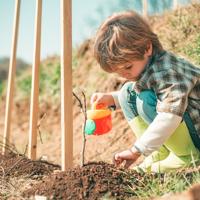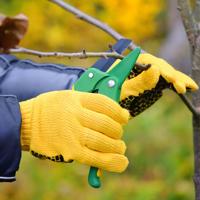Caring for your garden tools isn’t just about prolonging their lifespan; it’s a commitment to efficient and sustainable gardening. Clean and well-maintained tools can make your gardening tasks easier and more enjoyable.
Why Clean and Store Tools Properly?
Garden tools are akin to trusted companions in your botanical adventures. They frequently encounter dirt, sap, moisture, and other substances that can cause deterioration if not attended to properly. Maintaining them goes hand in hand with a garden-to-table lifestyle, as it reflects active participation in a sustainable and conscious approach to gardening.
Basic Cleaning Routine
Starting with a basic cleaning routine can greatly improve your tools’ condition. After each use:
-
Remove Dirt and Debris: Use a stiff brush to remove soil, sap, and residues. For stubborn substances, a putty knife or wire brush may be helpful.
-
Wash with Soap and Water: Wash tools in soapy water to eliminate remaining debris. A mild detergent often suffices.
-
Rinse and Dry: Ensure you thoroughly rinse tools to prevent rusting, and then dry them completely with a towel. Never store tools while wet.
Seasonal Deep Cleaning
A periodic deep clean is essential, especially when preparing for changes in seasons. This is a time to inspect tools for any signs of wear and tear.
-
Disassemble If Necessary: For complex tools like mowers or hedge trimmers, disassemble parts to clean crevices more efficiently.
-
Rust Removal: Use sandpaper or a rust remover to clean any rust spots. A vinegar soak can help with heavy rust.
-
Sharpen Blades: Tools with cutting edges, such as pruners and shears, benefit from regular sharpening. A sharpening stone or file may be used.
-
Oil Moving Parts: After cleaning and sharpening, apply a light coat of vegetable oil or linseed oil to moving parts, hinges, and blades to prevent rust.
Storage Practices
Once clean, how you store your tools plays a significant role in their longevity. A well-organized storage system can also save time when you’re eager to get planting.
-
Choose a Dry Location: Ensure your storage area is dry and well-ventilated. Moisture is the enemy of metal tools.
-
Hang Tools If Possible: Using wall hooks, pegboards, or specialized racks can keep tools off damp floors and safe from accidental damage.
-
Keep like-tools Together: It might be helpful to organize by type of tool or usage frequency, such as keeping digging tools separate from cutting implements.
-
Use Shelving for Small Tools: Hand tools and accessories can be kept on shelves or in bins for easy access.
Simple Maintenance Reminders
- Label a Storage Area: Consider labeling or color-coding tool storage areas for quick access.
- Inspect Regularly: Make it a habit to visually inspect tools every time you use them.
- Invest in Covers: For large tools stored outside, consider using protective covers.
Learning from Others
Engaging with community gardeners or local gardening clubs can offer additional insights into tool care. No single method suits everyone; sharing tips and personal experiences can reveal valuable new practices.
Resources and Further Reading
For those seeking more detailed guidance or tutorials on specific maintenance techniques, several online resources can be quite helpful. Websites like the University of Minnesota Extension or local agricultural extensions often publish maintenance guides specific to regional climates and conditions.
By investing time and care into cleaning and storing your gardening tools, you’ll not only preserve their efficacy but also contribute to a sustainable gardening ecosystem. The discipline of regularly maintaining these trusted instruments mirrors the very essence of nurturing life, whether in plants or habits.




